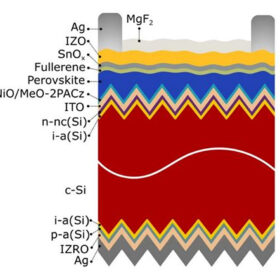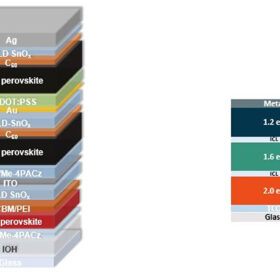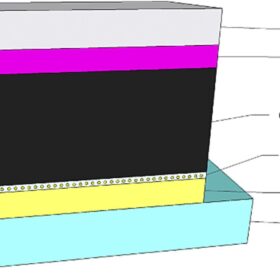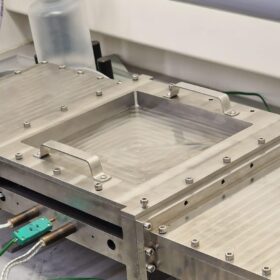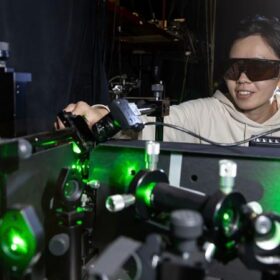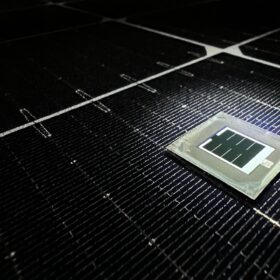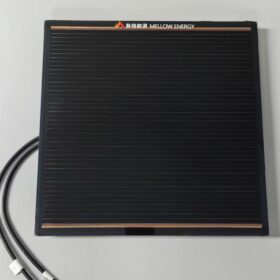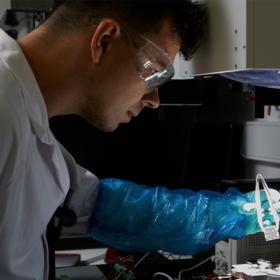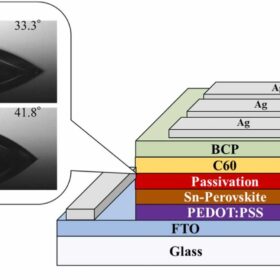Perovskite-silicon tandem solar cell with sublimed C60 source material achieves 30.9% efficiency
The result was certified by Fraunhofer ISE CalLab. The cell uses a top inverted PV device using an electron transport layer made of thermally evaporated buckminsterfullerene (C60) with minimized parasitic optical absorption.
All-perovskite triple-junction solar cell achieves 25.1% efficiency via new passivation technique
An international research team built the triple-junction device with dual bulk and interface passivation technique aimed at promoting halide homogeneity at the interface between the perovskite absorber and the hole-transport-layer. The 0.049 cm2 cell achieved a remarkable open-circuit voltage of 3.33 V and was also able to retain 80% of its initial efficiency after 200 h of continuous maximum power point tracking.
Improving perovskite solar cell performance with silver nanoparticles
Scientists in the United Kingdom have proposed for the first time to deposit silver nanoparticles in electron transport layers used in perovskite solar cells to improve device performance. They found that an “optimal” concentration of silver nanoparticles may help to improve a perovskite cell’s charge transfer and extraction, as well as its efficiency.
Aerosol process to boost perovskite solar cell performance
Aerosolar, a spinoff from the Queen Mary University of London, has created a novel aerosol method that it claims boosts efficiency and stability of metal halide perovskite solar cells.
‘Shallow defects’ key to high efficiency of perovskite solar cells, say researchers
Researchers at the Jülich Research Center in Germany have used novel photoluminescence measurements to analyze the recombination of charge carriers in perovskite solar cells. They have found that the loss of charge carriers in perovskite devices works differently from other types of PV cells.
Perovskite-silicon tandem solar modules must ensure degradation rate of 0.4%/year to compete with crystalline silicon
Researchers from Saudi Arabia’s King Abdullah University of Science and Technology (KAUST) investigated the commercial prospects of perovskite-silicon tandem PV technologies and found that, in order to bring them closer to market maturity, their cost should not exceed by 30% that of crystalline silicon counterparts. Their roadmap stresses the importance of reducing perovskite degradation and improving product stability.
Perovskite solar module based on new interconnection tech achieves 21.37% efficiency
Chinese solar perovskite specialist Mellow Energy and the Jinan University developed a new manufacturing process for perovskite solar modules that enables the formation of a protective layer at the interface between the perovskite absorber and the electron transport layer. This prevents the effusion of volatile components from the perovksite film.
Breakthrough for producing perovskite solar cells with AI
Researchers at RMIT University’s School of Science, Monash University and Australia’s Commonwealth Scientific and Industrial Research Organisation (CSIRO) have harnessed artificial intelligence to accelerate the design and production of perovskite solar cells.
Training AI to improve film quality in perovskite solar cells
With the aim of improving coating processes for large area thin films for high-performing perovskite solar cells, German and Swiss researchers have developed deep learning and explainable artificial intelligence (XAI) technology. The results suggest it can be used to define optimal coating process parameters more quickly and more accurately.
New passivation strategy paves the way for lead-free perovskite-silicon tandem solar cells
Scientists in Japan have developed a lead-free tin sulfide solar cell that is intended for applications in tandem perovskite-silicon PV devices. Through a new passivation technique based on the use of phenylsilane (PhSiH3) as a reducing agent, they were able to considerably increase the cell efficiency compared to a reference device with no PhSiH3 treatment.
